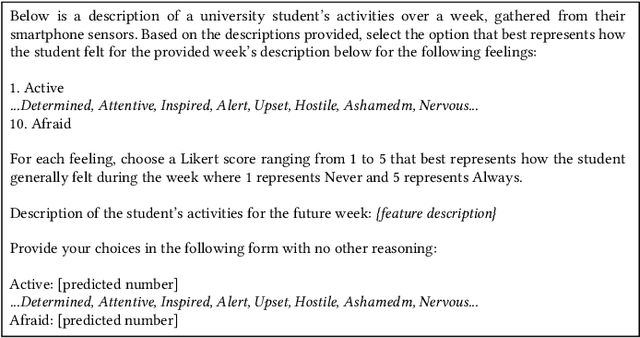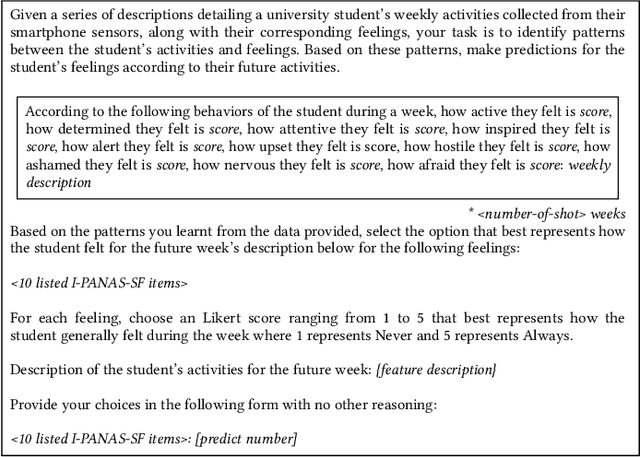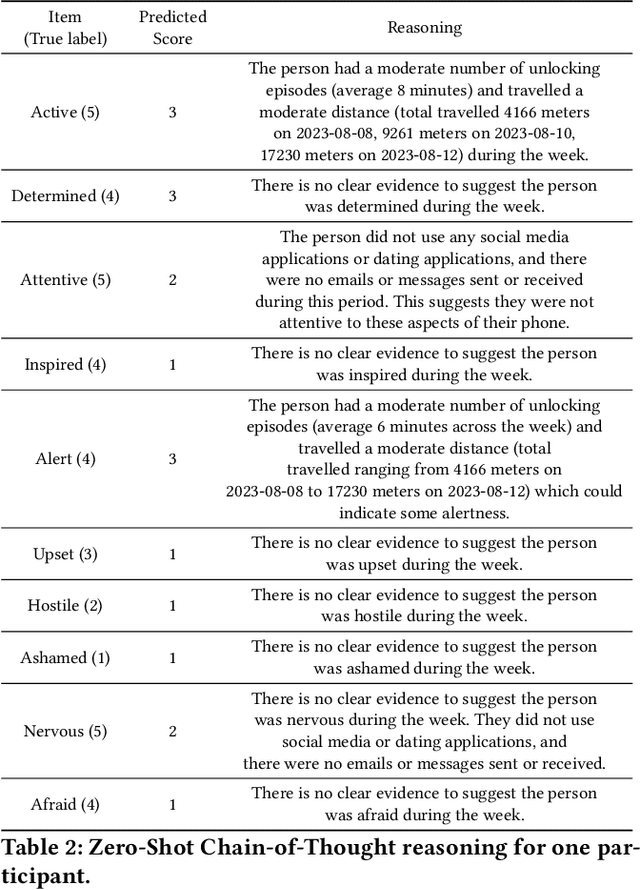Hong Jia
HealthSLM-Bench: Benchmarking Small Language Models for Mobile and Wearable Healthcare Monitoring
Sep 08, 2025Abstract:Mobile and wearable healthcare monitoring play a vital role in facilitating timely interventions, managing chronic health conditions, and ultimately improving individuals' quality of life. Previous studies on large language models (LLMs) have highlighted their impressive generalization abilities and effectiveness in healthcare prediction tasks. However, most LLM-based healthcare solutions are cloud-based, which raises significant privacy concerns and results in increased memory usage and latency. To address these challenges, there is growing interest in compact models, Small Language Models (SLMs), which are lightweight and designed to run locally and efficiently on mobile and wearable devices. Nevertheless, how well these models perform in healthcare prediction remains largely unexplored. We systematically evaluated SLMs on health prediction tasks using zero-shot, few-shot, and instruction fine-tuning approaches, and deployed the best performing fine-tuned SLMs on mobile devices to evaluate their real-world efficiency and predictive performance in practical healthcare scenarios. Our results show that SLMs can achieve performance comparable to LLMs while offering substantial gains in efficiency and privacy. However, challenges remain, particularly in handling class imbalance and few-shot scenarios. These findings highlight SLMs, though imperfect in their current form, as a promising solution for next-generation, privacy-preserving healthcare monitoring.
E-BATS: Efficient Backpropagation-Free Test-Time Adaptation for Speech Foundation Models
Jun 08, 2025Abstract:Speech Foundation Models encounter significant performance degradation when deployed in real-world scenarios involving acoustic domain shifts, such as background noise and speaker accents. Test-time adaptation (TTA) has recently emerged as a viable strategy to address such domain shifts at inference time without requiring access to source data or labels. However, existing TTA approaches, particularly those relying on backpropagation, are memory-intensive, limiting their applicability in speech tasks and resource-constrained settings. Although backpropagation-free methods offer improved efficiency, existing ones exhibit poor accuracy. This is because they are predominantly developed for vision tasks, which fundamentally differ from speech task formulations, noise characteristics, and model architecture, posing unique transferability challenges. In this paper, we introduce E-BATS, the first Efficient BAckpropagation-free TTA framework designed explicitly for speech foundation models. E-BATS achieves a balance between adaptation effectiveness and memory efficiency through three key components: (i) lightweight prompt adaptation for a forward-pass-based feature alignment, (ii) a multi-scale loss to capture both global (utterance-level) and local distribution shifts (token-level) and (iii) a test-time exponential moving average mechanism for stable adaptation across utterances. Experiments conducted on four noisy speech datasets spanning sixteen acoustic conditions demonstrate consistent improvements, with 4.1%-13.5% accuracy gains over backpropagation-free baselines and 2.0-6.4 times GPU memory savings compared to backpropagation-based methods. By enabling scalable and robust adaptation under acoustic variability, this work paves the way for developing more efficient adaptation approaches for practical speech processing systems in real-world environments.
Token-Level Logits Matter: A Closer Look at Speech Foundation Models for Ambiguous Emotion Recognition
May 24, 2025Abstract:Emotional intelligence in conversational AI is crucial across domains like human-computer interaction. While numerous models have been developed, they often overlook the complexity and ambiguity inherent in human emotions. In the era of large speech foundation models (SFMs), understanding their capability in recognizing ambiguous emotions is essential for the development of next-generation emotion-aware models. This study examines the effectiveness of SFMs in ambiguous emotion recognition. We designed prompts for ambiguous emotion prediction and introduced two novel approaches to infer ambiguous emotion distributions: one analysing generated text responses and the other examining the internal processing of SFMs through token-level logits. Our findings suggest that while SFMs may not consistently generate accurate text responses for ambiguous emotions, they can interpret such emotions at the token level based on prior knowledge, demonstrating robustness across different prompts.
Scaling Auditory Cognition via Test-Time Compute in Audio Language Models
Mar 30, 2025Abstract:Large language models (LLMs) have shown exceptional versatility in natural language processing, prompting recent efforts to extend their multimodal capabilities to speech processing through the development of audio large language models (Audio LLMs). While Audio LLMs excel in tasks such as speech recognition and synthesis, it remains unclear how they perform when faced with the auditory cognitive challenges posed by real-world environments, such as audio comprehension and listening recall, particularly in the presence of background noise or overlapping speech. Unlike text-based LLMs, which have access to vast amounts of text data for pre-training, retraining Audio LLMs with diverse auditory cognitive scenes is difficult due to the limited datasets that simulate real-world auditory cognitive scenarios and the challenge of acquiring auditory cognitive labels for training. While test-time compute (TTC) methods have been shown to enhance the capabilities of text-based LLMs during inference, a key challenge lies in designing these TTC methods to improve the auditory capabilities of Audio LLMs. This study aims to address these two research gaps by: i) exploring the auditory cognitive capabilities of Audio LLMs, and ii) enhancing their capabilities using TTC approaches. We have investigated five different Audio LLMs for auditory cognition using a \textit{self-collected} database and have proposed five TTC approaches to enhance auditory cognitive capabilities during inference. Our findings reveal that Audio LLMs performance decreases in more challenging auditory cognitive tasks. The proposed TTC approaches significantly enhance cognitive auditory capabilities, advancing the development of more adaptable and resilient Audio LLMs for practical applications such as assistive listening devices, voice-based AI assistants, and communication technologies.
LeanTTA: A Backpropagation-Free and Stateless Approach to Quantized Test-Time Adaptation on Edge Devices
Mar 20, 2025Abstract:While there are many advantages to deploying machine learning models on edge devices, the resource constraints of mobile platforms, the dynamic nature of the environment, and differences between the distribution of training versus in-the-wild data make such deployments challenging. Current test-time adaptation methods are often memory-intensive and not designed to be quantization-compatible or deployed on low-resource devices. To address these challenges, we present LeanTTA, a novel backpropagation-free and stateless framework for quantized test-time adaptation tailored to edge devices. Our approach minimizes computational costs by dynamically updating normalization statistics without backpropagation, which frees LeanTTA from the common pitfall of relying on large batches and historical data, making our method robust to realistic deployment scenarios. Our approach is the first to enable further computational gains by combining partial adaptation with quantized module fusion. We validate our framework across sensor modalities, demonstrating significant improvements over state-of-the-art TTA methods, including a 15.7% error reduction, peak memory usage of only 11.2MB for ResNet18, and fast adaptation within an order-of-magnitude of normal inference speeds on-device. LeanTTA provides a robust solution for achieving the right trade offs between accuracy and system efficiency in edge deployments, addressing the unique challenges posed by limited data and varied operational conditions.
Foundation Models for Anomaly Detection: Vision and Challenges
Feb 10, 2025



Abstract:As data continues to grow in volume and complexity across domains such as finance, manufacturing, and healthcare, effective anomaly detection is essential for identifying irregular patterns that may signal critical issues. Recently, foundation models (FMs) have emerged as a powerful tool for advancing anomaly detection. They have demonstrated unprecedented capabilities in enhancing anomaly identification, generating detailed data descriptions, and providing visual explanations. This survey presents the first comprehensive review of recent advancements in FM-based anomaly detection. We propose a novel taxonomy that classifies FMs into three categories based on their roles in anomaly detection tasks, i.e., as encoders, detectors, or interpreters. We provide a systematic analysis of state-of-the-art methods and discuss key challenges in leveraging FMs for improved anomaly detection. We also outline future research directions in this rapidly evolving field.
LightLLM: A Versatile Large Language Model for Predictive Light Sensing
Nov 20, 2024



Abstract:We propose LightLLM, a model that fine tunes pre-trained large language models (LLMs) for light-based sensing tasks. It integrates a sensor data encoder to extract key features, a contextual prompt to provide environmental information, and a fusion layer to combine these inputs into a unified representation. This combined input is then processed by the pre-trained LLM, which remains frozen while being fine-tuned through the addition of lightweight, trainable components, allowing the model to adapt to new tasks without altering its original parameters. This approach enables flexible adaptation of LLM to specialized light sensing tasks with minimal computational overhead and retraining effort. We have implemented LightLLM for three light sensing tasks: light-based localization, outdoor solar forecasting, and indoor solar estimation. Using real-world experimental datasets, we demonstrate that LightLLM significantly outperforms state-of-the-art methods, achieving 4.4x improvement in localization accuracy and 3.4x improvement in indoor solar estimation when tested in previously unseen environments. We further demonstrate that LightLLM outperforms ChatGPT-4 with direct prompting, highlighting the advantages of LightLLM's specialized architecture for sensor data fusion with textual prompts.
Order Is All You Need for Categorical Data Clustering
Nov 19, 2024Abstract:Categorical data composed of nominal valued attributes are ubiquitous in knowledge discovery and data mining tasks. Due to the lack of well-defined metric space, categorical data distributions are difficult to intuitively understand. Clustering is a popular technique suitable for data analysis. However, the success of clustering often relies on reasonable distance metrics, which happens to be what categorical data naturally lack. Therefore, the cluster analysis of categorical data is considered a critical but challenging problem. This paper introduces the new finding that the order relation among attribute values is the decisive factor in clustering accuracy, and is also the key to understanding the categorical data clusters. To automatically obtain the orders, we propose a new learning paradigm that allows joint learning of clusters and the orders. It turns out that clustering with order learning achieves superior clustering accuracy, and the learned orders provide intuition for understanding the cluster distribution of categorical data. Extensive experiments with statistical evidence and case studies have verified the effectiveness of the new ``order is all you need'' insight and the proposed method.
StatioCL: Contrastive Learning for Time Series via Non-Stationary and Temporal Contrast
Oct 14, 2024Abstract:Contrastive learning (CL) has emerged as a promising approach for representation learning in time series data by embedding similar pairs closely while distancing dissimilar ones. However, existing CL methods often introduce false negative pairs (FNPs) by neglecting inherent characteristics and then randomly selecting distinct segments as dissimilar pairs, leading to erroneous representation learning, reduced model performance, and overall inefficiency. To address these issues, we systematically define and categorize FNPs in time series into semantic false negative pairs and temporal false negative pairs for the first time: the former arising from overlooking similarities in label categories, which correlates with similarities in non-stationarity and the latter from neglecting temporal proximity. Moreover, we introduce StatioCL, a novel CL framework that captures non-stationarity and temporal dependency to mitigate both FNPs and rectify the inaccuracies in learned representations. By interpreting and differentiating non-stationary states, which reflect the correlation between trends or temporal dynamics with underlying data patterns, StatioCL effectively captures the semantic characteristics and eliminates semantic FNPs. Simultaneously, StatioCL establishes fine-grained similarity levels based on temporal dependencies to capture varying temporal proximity between segments and to mitigate temporal FNPs. Evaluated on real-world benchmark time series classification datasets, StatioCL demonstrates a substantial improvement over state-of-the-art CL methods, achieving a 2.9% increase in Recall and a 19.2% reduction in FNPs. Most importantly, StatioCL also shows enhanced data efficiency and robustness against label scarcity.
Leveraging LLMs to Predict Affective States via Smartphone Sensor Features
Jul 11, 2024



Abstract:As mental health issues for young adults present a pressing public health concern, daily digital mood monitoring for early detection has become an important prospect. An active research area, digital phenotyping, involves collecting and analysing data from personal digital devices such as smartphones (usage and sensors) and wearables to infer behaviours and mental health. Whilst this data is standardly analysed using statistical and machine learning approaches, the emergence of large language models (LLMs) offers a new approach to make sense of smartphone sensing data. Despite their effectiveness across various domains, LLMs remain relatively unexplored in digital mental health, particularly in integrating mobile sensor data. Our study aims to bridge this gap by employing LLMs to predict affect outcomes based on smartphone sensing data from university students. We demonstrate the efficacy of zero-shot and few-shot embedding LLMs in inferring general wellbeing. Our findings reveal that LLMs can make promising predictions of affect measures using solely smartphone sensing data. This research sheds light on the potential of LLMs for affective state prediction, emphasizing the intricate link between smartphone behavioral patterns and affective states. To our knowledge, this is the first work to leverage LLMs for affective state prediction and digital phenotyping tasks.
 Add to Chrome
Add to Chrome Add to Firefox
Add to Firefox Add to Edge
Add to Edge